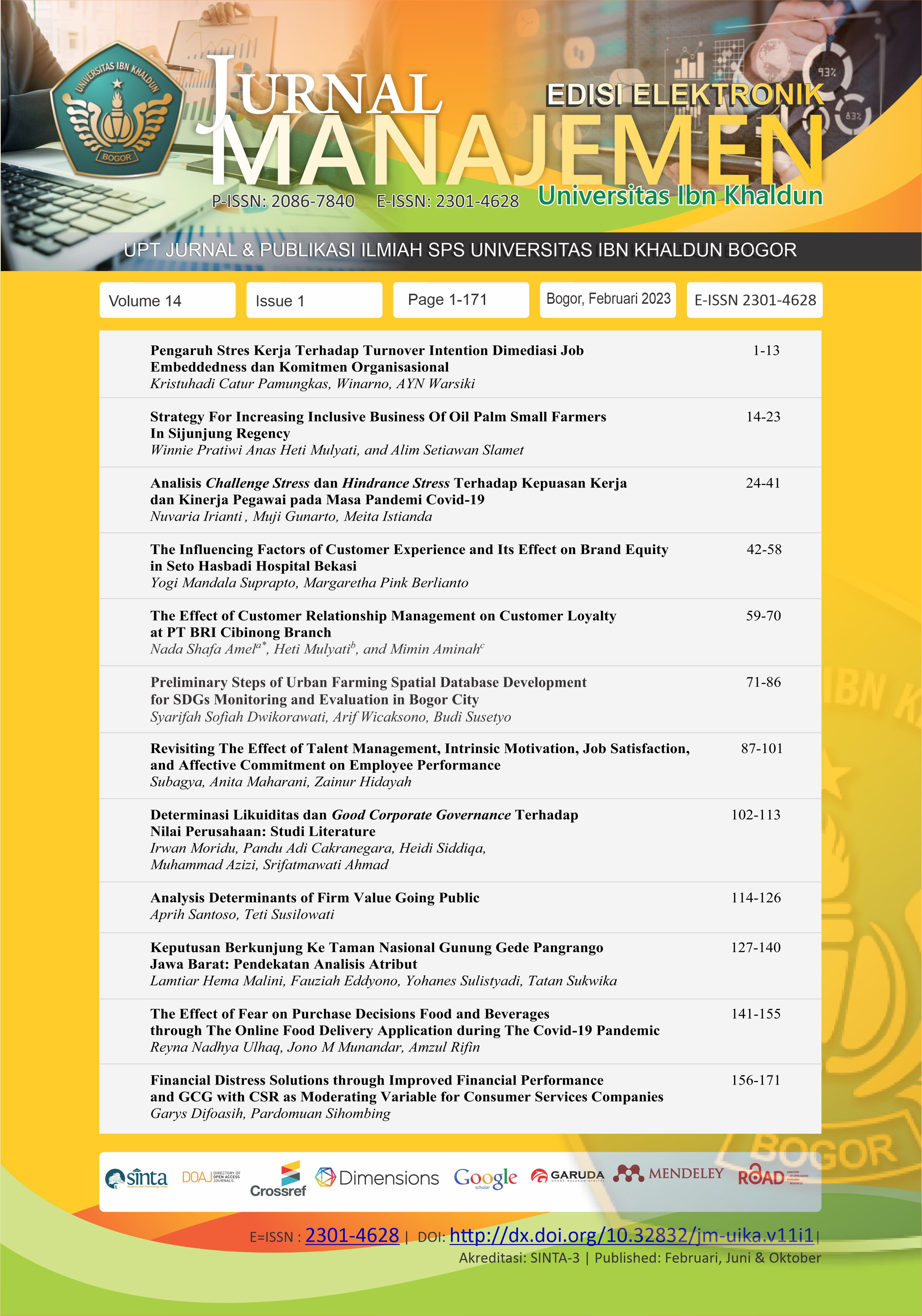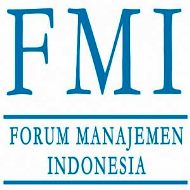The Effect of Customer Relationship Management on Customer Loyalty at PT BRI Cibinong Branch
DOI:
https://doi.org/10.32832/jm-uika.v14i1.8405Keywords:
Bank, CRM, Customer Satisfaction, SEMAbstract
The banking sector has an influence on the economy of a country. Service quality is the main requirement that determines the success of banking as a company engaged in service providers. Bank BRI Cibinong is one of BRI's branch offices in Cibinong District. The main goal of the banking business is to make enormous profits so that the company can survive. One of BRI's initiatives to cultivate long-term relationships with customers is to create customer satisfaction through responsiveness in answering customer complaints. Customer loyalty is a valuable company asset that must be maintained and is an absolute must for Bank BRI to exist and win the competition. The key performance indicator (KPI) of BRICare Cibinong Branch demonstrates that most of the customer complaints reports have not passed the 90 percent standard of assessment. The goal of this study is to analyze the factors that influence customer satisfaction through customer relationship management (CRM) and their impact on customer loyalty. Descriptive analysis and Covariance Based-Structural Equation Modeling (CB-SEM) were used as analytical methods. CRM variables including complaint handling, cross selling, technology adoption and customer appreciation have a positive impact on customer satisfaction. The complaint handling variable has the biggest coefficient value in creating customer satisfaction.
References
Azzam, Z. A. M. (2014). The Impact Of Customer Relationship Management On Customer Satisfaction In The Banking Industry –A Case Of Jordan. European Journal Of Business And Management. 6(32). https://www.iiste.org/Journals/index.php/EJBM/article/view/16867/17202
Bagozzi, R., Youjae, Yi. (1988). On The Evaluation Of Structural Equation Models. Journal of the Academy of Marketing Science. 16(1):74-94. http://dx.doi.org/10.1007/BF02723327
Baron, R. M., dan Kenny, D. A. (1986). The Moderator-Mediator Variable Distinction In Social Psychological Research: Conceptual, Strategic and Statistical Considerations. Psychological Association Inc. 51(6). DOI:10.1037//0022-3514.51.6.1173
Bentler, P. M., dan Bonett, D.G. (1980). Significance Tests and Goodness Of Fit In The Analysis Of Covariance Structures. Psychological Bulletin. 88:588-606. https://doi.org/10.1037/0033-2909.88.3.588
Berry, L. L. (1995). Relationship Marketing Of Services-Growing Interest Emerging Perspectives. Journal Of The Academy Of Marketing Science. 23(4):236-245. https://doi.org/10.1177/009207039502300402
Bompolis, C.G., Boutsouki C. (2014). Customer Relationship Management In The Era Of Social Web And Social Customer: An Investigation Of Customer Engagement In The Greek Retail Banking Sector. Social and Behavioral Sciences. 148:67-78. DOI:10.1016/J.SBSPRO.2014.07.018
Boshoff, C., dan Allen, J. (2000). The influence of selected antecedents on frontline staff's perceptions of service recovery performance. International Journal of Service Industry Management. 11(1):63-90. https://doi.org/10.1108/09564230010310295
[BRI] Bank Rakyat Indonesia. (2019). Tak Pernah Berhenti Menumbuh kembangkan dan Memberdayakan yang Kecil Menjadi Semakin Berarti Bagi Negeri, Laporan Tahunan 2019. Jakarta:BRI.
Butera, A. (2000). Cross-selling: Capitalizing On The Opportunities. Hoosier Bank. 87(7):14-16.
Chakiso, B. C. (2015). The effect of relationship marketing on customer's loyalty (evidence from Zemen Bank). Emerging markets journal. 5(2):2158-8708. DOI:10.5195/emaj.2015.84
Chen, J., dan Rusell, K.H. (2007). The effect of mobile customer relationship management on customer loyalty: brand image does matter. Proceedings of the 40th Hawaii international conference on system science. DOI:10.1109/HICSS.2007.526
Ferdinand, A. (2000). Structural Equation Modelling Dalam Penelitian Manajemen. Semarang: Badan Penerbit Universitas Diponegoro.
Hair, J.F., Black, W. C., Babin, B. J., dan Anderson, R. E. (2010). Multivariate Data Analysis (7th ed.) NJ: Prentice Hall.
Hair, J. F., Ringle, C. M., dan Sarstedt, M. (2014). A Primer On Partial Least Squares Structural Equation Modeling (PLS-SEM). Thousand Oaks:Sage
Hu, L., Bentler, P. M. (1999). Cutoff Criteria For Fit Indexes In Covariance Structure Analysis: Conventional Criteria Versus New Alternatives. Structural Equation Modeling: A Multidisciplinary Journal. 6:1-55. https://doi.org/10.1080/10705519909540118
Jain, R., Jain, S., dan Dhar, U. (2007). CUREL: A scale for measuring customer relationship management effectiveness in the service sector. Journal of Services Research. Vol 7 No 1. https://go.gale.com/ps/i.do?p=AONE&u=anon~4dbb991d&id=GALE|A186862339&v=2.1&it=r&sid=googleScholar&asid=7808347b
Jindal, L. (2017). Customer relationship Management in Banking Sector. Journal of management research and analysis. 4(3):140-144.
Khotijah, S. dan Sugiyono, A. (2021). Pengaruh Fee Based Income Dan Interest Income Terhadap Pendapatan Perusahaan (Studi Empiris Bank BUMN Indonesia Periode 2010-2019). Jurnal Pemikiran Dan Penelitian Ekonomi. 9(1): 23-34. DOI: https://doi.org/10.31102/equilibrium.9.01.23-34
Kolodinsky, J.M., Hogarth, J. M., dan Hilgert, M. A. (2004). The adoption of electronic banking technologies by US consumers. International Journal of Bank Marketing. 22(4):238-259. https://doi.org/10.1108/02652320410542536
Kori, G.V., dan Huggi, S.B. (2012). Customer relationship management in the banking industry. Indian journal of applied research. vol 1 issue 7.
Kotler, P. dan Keller, K.L. (2007). Manajemen Pemasaran (terjemahan) Jilid 2. PT Indeks: Jakarta.
Lam, A. Y. C., Cheung, R., dan Lau, M. M. (2013). The Influence Of Internet-based Customer Relationship Management On Customer Loyalty. Contemporary Management Research. 9(4):419-440. DOI:10.7903/cmr.11095
Nardiman. (2017). Pengaruh Customer Relationship Management dan Customer Value Terhadap Nasabah dan Dampaknya Pada Loyalitas Nasabah Bank BRI Unit Tiku Cabang Bukittinggi. Jurnal EKOBISTEK . 6(2):251-262. https://doi.org/10.5281/zenodo.1242939
Nasaireh, M. A. (2020). Developing and Validating Instruments for Measurement of Organizational Culture Dimensions for Organizational Development Achievement. 2(5), 168–174.
Riquelme, H.E., dan Rios, R. E. (2010). The moderating effect of gender in the adoption of mobile banking. International Journal of bank marketing. 28(5):328-341. https://doi.org/10.1108/02652321011064872
Shi, D., Lee, T., dan Alberto, M. O. (2019). Understanding The Model Size Effect On SEM Fit Indices. Educational and Psychological Measurement. 79(2): 310-334. https://doi.org/10.1177/0013164418783530
Siddiqi, T., Khan, A.K., dan Sharna, M.S. (2018). Impact Of Customer Relationship Management On Customer Loyalty: Evidence From Bangladesh's Banking Industry. International Journal Of Business, Economics And Law. 15(5) Issn 2289-1552.
Vazifehdust, H., Shahnavazi, A., Jourshari, M.R.T., dan Fataneh, S.S. (2012). Investigation Critical Success Factors of Customer Relationship Management Implementation. World Applied Sciences Journal. 18(8):1052-1064. DOI:10.5829/idosi.wasj.2012.18.08.3751
Vyas, R. S., dan Math, N. R. B. (2006). A Comparative Study Of Cross-Selling Practices In Public And Private Sector Banks In India. Journal Of Financial Services Marketing. 10(4):123- 134. DOI:10.1057/palgrave.fsm.4760027
Downloads
Published
How to Cite
Issue
Section
License
Authors who publish with this journal agree to the following terms:
- Authors retain copyright and grant the journal right of first publication with the work simultaneously licensed under a Creative Commons Attribution-NonCommercial-ShareAlike 4.0 International License that allows others to share the work with an acknowledgement of the work's authorship and initial publication in this journal.
- Authors can enter into separate, additional contractual arrangements for the non-exclusive distribution of the journal's published version of the work (e.g., post it to an institutional repository or publish it in a book), with an acknowledgement of its initial publication in this journal.
- Authors are permitted and encouraged to post their work online (e.g., in institutional repositories or on their website) prior to and during the submission process, as it can lead to productive exchanges, as well as earlier and greater citation of published work (See The Effect of Open Access).











